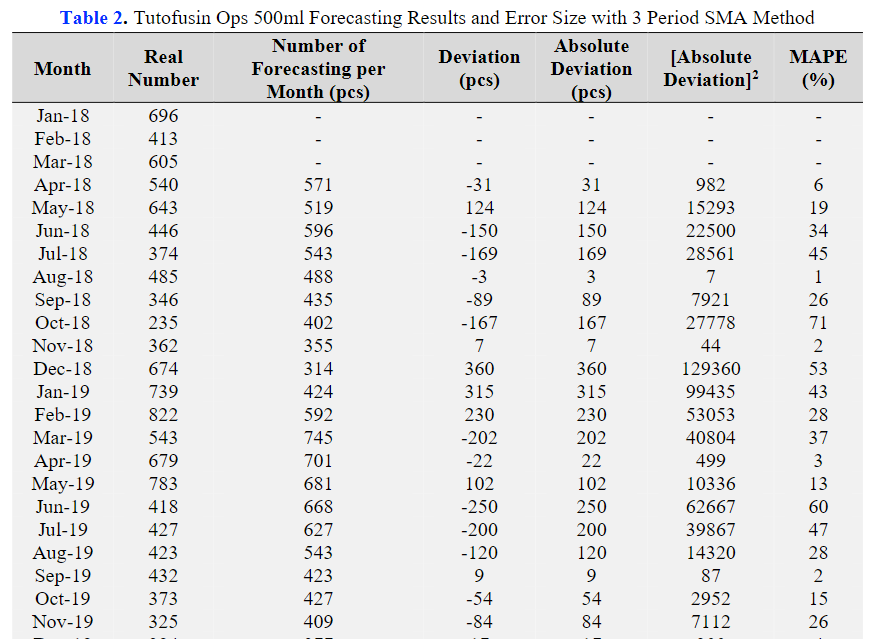Main Article Content
Abstract
Drug management at the Academic Hospital of Gadjah Mada University found that the damaged and expired drugs amounted to 4.71% and the dead stock was 7.89%. One of the influential factors to contribute to the considerable amount of damaged and expired drugs and dead stock is inaccurate planning. Forecasting is one aspect of planning, which helps predict the upcoming event as a way to make planning more effective and efficient. One of the forecasting methods is the 3-period Single Moving Average (SMA). This study aims to forecast drug demand in January 2021 at the Academic Hospital of Gadjah Mada and to see the size of the error using the 3-period SMA method. This is an observational study with the retrsospective descriptive analysis. The research population is all drugs used at the Academic Hospital of Gadjah Mada in January 2018-December 2020. The samples are the top 5 most used drugs based on A category resulted from the ABC analysis of consumption in 2020 with certain criteria using purposive sampling technique. The drug demand was forecasted using Eviews 12 software and its error size, particularly the Mean Absolute Percentage Error (MAPE) was calculated using Microsoft Excel. The results showed that the forecast of drug demand in January 2021 was Tutofusin Ops 500ml 496pcs, Hemapo 2000 IU/ml 290pcs, Hemapo 3000 IU/ml 219pcs, Abilify Discmelt 10mg 717pcs, and Otsu-NS Piggyback 3736pcs. The calculated MAPE value was 8-32%, which means that the 3 period SMA forecasting is acceptable and reasonable for further application at the Academic Hospital of Gadjah Mada
Keywords
Article Details

This work is licensed under a Creative Commons Attribution-NonCommercial 4.0 International License.
References
- Adhikari, R., & Agrawal, R. K. (2013). An introductory study on time series modeling and forecasting. In arXiv preprint arXiv:1302.6613. arXiv. https://doi.org/10.48550/arXiv.1302.6613
- Akbar, N. dkk. (2016). Analisis Manajemen Penyimpanan Obat Di Puskesmas Se-Kota Banjarbaru. Jurnal Manajemen Dan Pelayanan Farmasi (Journal of Management and Pharmacy Practice), 6(4), 255–260. https://doi.org/10.22146/jmpf.354
- Arsyad, L. (2009). Peramalan Bisnis (Pertama). Fakultas Ekonomi UGM.
- Dewi, E. K., Dahlui, M., Chalidyanto, D., & Rochmah, T. N. (2020). Achieving cost-efficient management of drug supply via economic order quantity and minimum-maximum stock level. Expert Review of Pharmacoeconomics & Outcomes Research, 20(3), 289–294. https://doi.org/10.1080/14737167.2019.1633308
- Hudaningsih, N., Utami, S. F., & Jabbar, W. A. A. (2020). Perbandingan Peramalan Penjualan Produk Aknil Pt. Sunthi Sepurimengguanakan Metode Single Moving Average Dan Single Exponential Smooting. Jurnal Informatika Teknologi Dan Sains, 2(1), 15–22. https://doi.org/10.51401/jinteks.v2i1.554
- Irawan, F., Sumijan, S., & Yuhandri, Y. (2021). Prediksi Tingkat Produksi Buah Kelapa Sawit dengan Metode Single Moving Average. Jurnal Informasi Dan Teknologi, 3(4), 251–256. https://doi.org/10.37034/jidt.v3i4.162
- Kementerian Kesehatan RI. (2016). Peraturan Menteri Kesehatan Republik Indonesia No. 72 tahun 2016 tentang Standar Pelayanan Kefarmasian di Rumah Sakit.
- Kementerian Kesehatan RI. (2019). Pedoman Penyusunan Rancangan Kebutuhan Obat dan Pengendalian Persediaan Obat di Rumah Sakit.
- Lumy, D. R. (2012). Forecasting Analysis Of Pharmaceuticals And Medical Devices In A Category Needed In 2011. Jurnal Manajemen Dan Pelayanan Farmasi (Journal of Management and Pharmacy Practice), 2(4), 214–219. https://doi.org/10.22146/jmpf.87
- Manurung, N. (2020). Application Of The Single Moving Average (SMA) Method For Forecasting Sales Of Horden In Umi Nala’s Shop Business. International Conference on Social, Sciences and Information Technology, 1(1), 297–306. https://doi.org/10.33330/icossit.v1i1.912
- Mellen, R. C., & Pudjirahardjo, W. J. (2013). Faktor Penyebab dan Kerugian Akibat Stockout dan Stagnant Obat di Unit Logistik RSU Haji Surabaya. Jurnal Administrasi Kesehatan Indonesia, 1(1), 99–107.
- Moreno, J. J. M., Pol, A. P., Abad, A. S., & Blasco, B. C. (2013). Using the R-MAPE index as a resistant measure of forecast accuracy. Psicothema, 25(4), 500–506. https://doi.org/10.7334/psicothema2013.23
- Pudjaningsih, D. (1996). Pengembangan Indikator Efisiensi Pengelolaan Obat di Farmasi RS. Program Pasca Sarjana. Fakultas Kedokteran. Universitas Gadjah Mada. Yogyakarta.
- Rais, A. N., Rousyati, R., Thira, I. J., Kholifah, D. N., Purwati, N., & Kristania, Y. M. (2020). Evaluasi Metode Forecasting pada Data Kunjungan Wisatawan Mancanegara ke Indonesia. EVOLUSI: Jurnal Sains Dan Manajemen, 8(2), 104–115. https://doi.org/10.31294/evolusi.v8i2.8971
- Rusdiana, S., Yuni, S. M., & Khairunnisa, D. (2020). Comparison of Rainfall Forecasting in Simple Moving Average (SMA) and Weighted Moving Average (WMA) Methods (Case Study at Village of Gampong Blang Bintang, Big Aceh District-Sumatera-Indonesia). Journal of Research in Mathematics Trends and Technology, 2(1), 21–27. https://talenta.usu.ac.id/jormtt/article/view/3753/2578
- Satibi. (2016). Manajemen Obat Di Rumah Sakit. Gadjah Mada University Press.
- Subagyo, P. (2000). Forecasting: konsep dan aplikasi. BPFE Yogyakarta.
- Taufiqurohman, T. (2021). Efisiensi Pengelolaan Obat Menggunakan Pendekatan Lean Management di Instalasi Farmasi dan Sterilisasi RS Akademik UGM. The Journal of Hospital Accreditation, 3(01), 22–26. https://doi.org/10.35727/jha.v3i01.70
- Zahra, I. A. (2020). Analisis Perbandingan Teknik Peramalan Kebutuhan Obat Dengan Metode Arima Dan Single Eksponensial Smoothing Studi Kasus: Rsud Indramayu. Jurnal Tata Kelola Dan Kerangka Kerja Teknologi Informasi, 6(1), 23–29. https://doi.org/10.34010/jtk3ti.v6i1.2261
